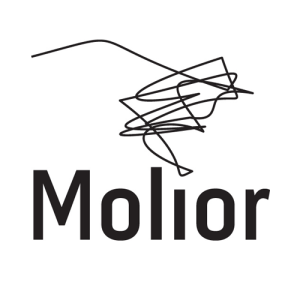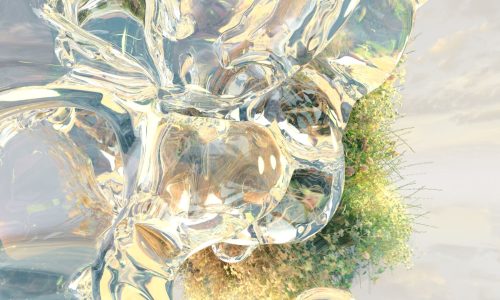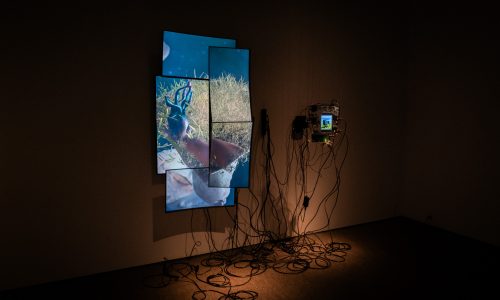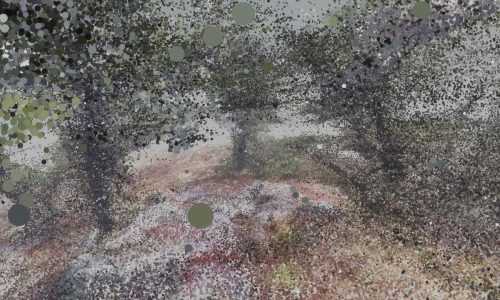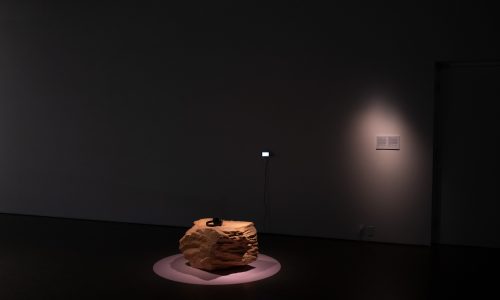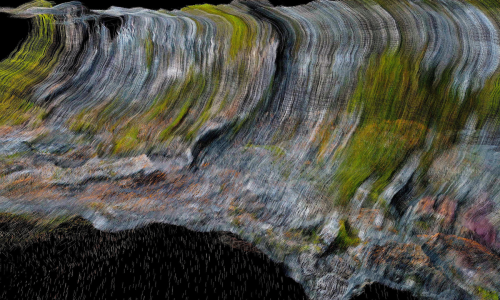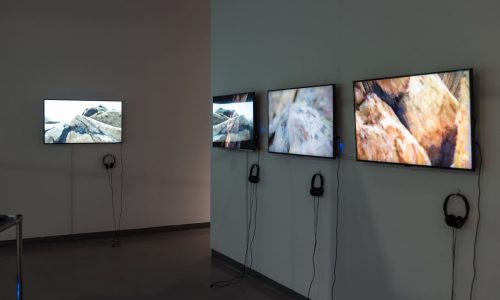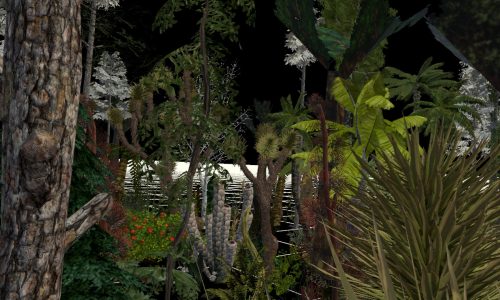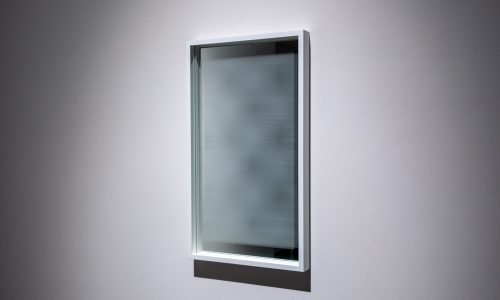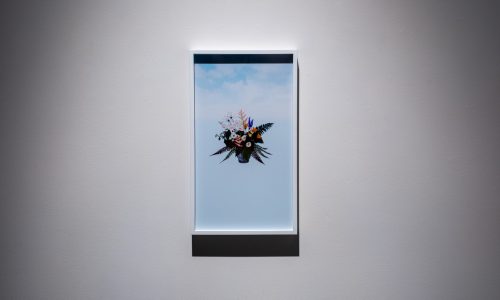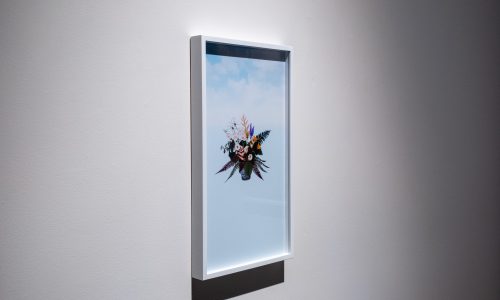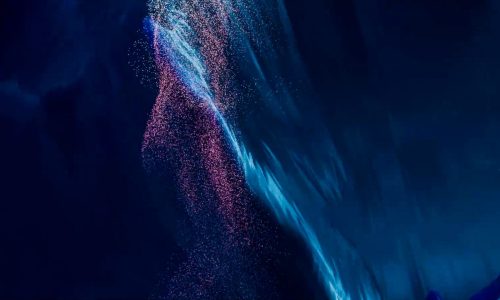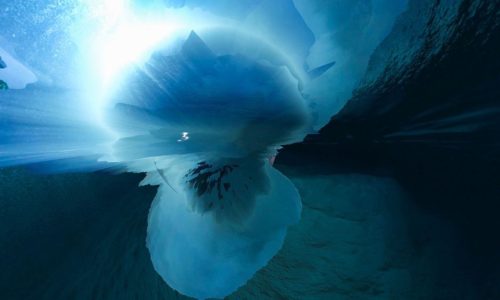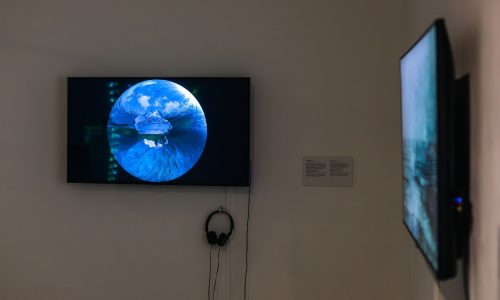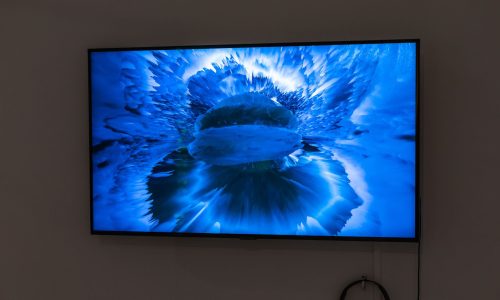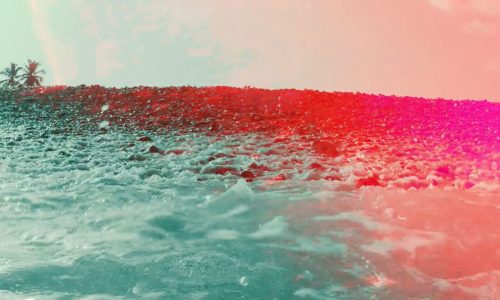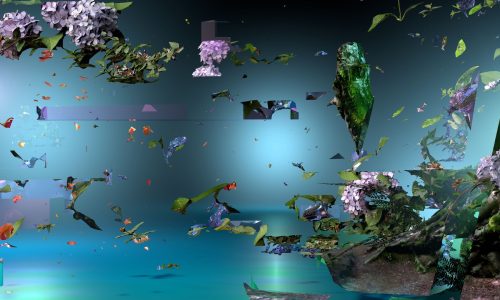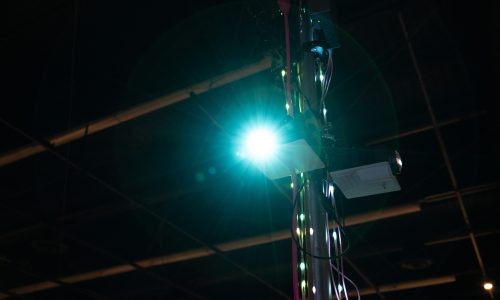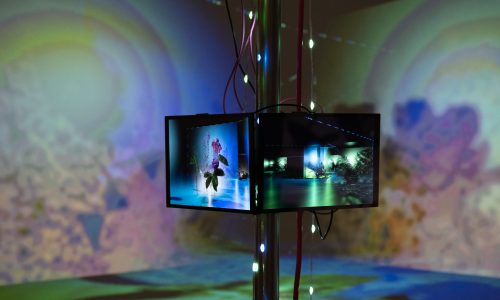New Surroundings: Approaching the Untouchable
Across Quebec, Canada
From December 2024 to March 2026
Curator
Nathalie Bachand
Molior organizes a Quebec tour of its virtual reality exhibition, New Surroundings: Approaching the Untouchable. This poetic experience under the theme of nature’s fragility will be hosted in six Quebec cities—Val-d’Or, Chicoutimi, Gatineau, Quebec City, Sherbrooke, and Carleton-sur-Mer—from December 2024 to March 2026, thanks to an exceptional collaboration with six province-wide exhibition presenters.
Centre d’exposition de Val-d’Or (VOART), from December 7th, 2024, to January 26th, 2025
centre Bang in Chicoutimi, from February 21st to April 26, 2025
DAÏMÔN in Gatineau, from May 23rd to June 19th, 2025
Productions Recto-Verso in Quebec city, from August 29th to September 21st, 2025
Sporobole in Sherbrooke, from September 27th to November 21st, 2025
Centre d’artistes Vaste et Vague in Carleton-sur-Mer, from January 10th to February 28th, 2026
Produced in 2023 by Molior, New Surroundings: Approaching the Untouchable, curated by Nathalie Bachand, brings together seven prominent artists from Quebec: Baron Lanteigne, Caroline Gagné, François Quévillon, Olivia McGilchrist, the duo Laurent Lévesque and Olivier Henley, and Sabrina Ratté. Molior produced three of the six virtual reality works specially for the occasion.
Nature, this raw material of the terrestrial environment, is the self-generating whole comprised of all the earth’s materials—at least for the time being so long as the environmental parameters have not been completely disrupted by the climate change currently underway.
It is also a subject-object that has been—through every era and in every current—widely depicted, shown, quoted, transformed, remixed through artistic representation. The sublime subject par excellence, the natural event is one that we have the least influence over. If nature is a facet of our reality that often escapes us—and by the same token fascinates and obsesses us—its interpretation through the workings of the digital brings about an almost ontological reversal: its very materiality is put into question, it becomes malleable and immaterial all at once.
3D animation, modeling and photogrammetry are the vectors of a transition to the digital where nature becomes the intangible and untouchable material of worlds in which human destruction no longer exists. On the contrary, the human gesture—which here becomes an artistic one —is rather one that constructs, makes and arranges, composes and develops. The change takes place here only at the price of a perceptive variation: nothing is ever lost, we only see/show differently.
New Surroundings: Approaching the Untouchable brings together works that, each in their own way, question the materiality of the world through an exploration of digital material. With Virtual Reality as their common denominator, these universes belong to an order where the most distant seems to also be the most accessible, while the impalpable offers the appearance of being at hand. This world, revealed by the digital—modified, reorganized, and augmented—is, however, less and less foreign to our own, which changes, deteriorates and gradually disappears. Far from being immutable, the nature we move about in —its sky, its lands and its seas—is perhaps at the dawn of its own ontological reversal and, in any case, certainly at the threshold of an irreversible turnaround.
– Nathalie Bachand
Nathalie Bachand
Nathalie Bachand is an independent curator interested in issues pertaining to the digital, its challenges and the conditions of its emergence in contemporary art.
Among her curatorial projects, her exhibition The Dead Web – The End, initially presented at Eastern Bloc (2017), was co-produced by Molior in Europe: at the Mirage Festival in Lyon (2019), at the Mapping Festival in Geneva (2019), and at the Ludwig Museum in Budapest (2020), co-curated with Béla Tamás Kónya; she was a guest curator for Art Souterrain 2021 Chronométrie; her exhibition project, DataffectS, was presented at the Galerie de l’UQAM (2022); she co-curated, with Sarah Ève Tousignant, the SIGHT+SOUND 2022 Dancing While Waiting (For the End of the World) festival, organized by Eastern Bloc (2022) – Grand Prix du Conseil des arts de Montréal finalist; and her exhibition New Surroundings: Approaching the Untouchable, produced by Molior, was presented at the Livart (2023).
She is a member of the International Association of Art Critics (AICA), SALOON Montreal cofounder, and sits on the Board of Directors of Avatar in Quebec City.
Previously in charge of development for ELEKTRA-BIAN (2006-2016), she is currently Director of Digital Arts Development at Sporobole.
She lives and works in Montreal.
Baron Lanteigne
Ascension
2022
Virtual reality
Description of the work
Ascension invites the visitor to explore an environment whose behaviour revolves around a central element: an ascending/descending liquid that refracts light. Counter-intuitive but based on an internal consistency, the core of this suspended landscape unfolds through the manipulation of a data flow exchanged by connected devices. By moving, it is possible to slow down the movement of this substance in order to better observe it, or to be carried away by the dizzying acceleration of the scene. An ceaseless blossoming of hands all around, reminds us that these are both the source and the condition of the continuous omni-connection that characterizes our actual relationship to the world. Baron Lanteigne is interested in the particularities that allow us to interpret an image as a physical place, whether it be perspective, horizon, or Euclidean architecture. With Ascension, he revisits this logic by structuring a space and a “nature” according to other rules.
This artwork is presented as a world premiere.
Biography
Baron Lanteigne lives and works in Quebec City, Canada. The essence of his work emerges from infiltrations and collaborations with many web-native communities. His work is part of online events and collections such as The Wrong Biennale, real-fake.org, Electrofringe, SPAMM, Glitch Artist Collective, FeltZine, MoCDA and many more. This online practice is exhibited worldwide at among others Ludwig Museum in Budapest (HU), Canadian Cultural Centre in Paris (FR), Ramat Gan Museum of Israeli Art (IL), Mapping Festival (CH), Mirage Festival (FR), MUTEK (CA, JP), Dutch Design Week (NL), Sónar+D (ES), CPH:DOX (DK) and the Gwangju Media Platform (KR).
Credits
Integration on Unity: Renaud Gervais
Soundtrack: Marie Anne Bérard
Ascension is a production of Molior, with the support of the Canada Council for the Arts.
Baron Lanteigne
Cinématographie de la matière virtuelle : Touch Grass
2023
Installation
3D animation, video, screens, microprocessors, cables
Description of the work
Touch Grass: this expression is commonly used in the context of Internet culture to signify one’s presence and participation in the real world, as opposed to the connected reality of online virtual worlds. Could it be an ironic invitation to leave the screen behind? Or a critical commentary on the digital invasion of our lives? Either way, the work speaks to us of “touching” things IRL (in real life) and, AFK (away from keyboard), of reconnecting with a world that increasingly eludes us. Indeed, the omnipresence of digital technology is persistently distancing us from tangible reality, while at the same time the scale of our ecological footprint is contributing to a very real loss of grip. Fragmented into several screens, the gesture of touching vegetation is (re)formed and literally programmed from microprocessors suspended nearby. Then, as a reading key, a screen acts as a window on the Internet, through which web browsing reveals – sometimes humorously – the meaning of touching grass.
Credits
Discord integration: Maxime Alexandre Gosselin
The artist thanks Agence TOPO.
Caroline Gagné
Autofading_Se disparaître
2020
Virtual reality
Description of the work
The work draws on virtual reality technologies and non-linear sound composition to question, in a poetic way, the presence of the human being in their environment. The spectator is immersed in the heart of a forest generated in “cloud points,” which evolves according to the attitude of observation and attention that he privileges. The experience begins in a windswept and foggy virtual environment where snow is falling from the sky. As the spectator adopts slow movements, the wind calms down and the fog dissipates. Noises gradually appear: a stream flows, a fluttering of wings, a cracking or crumpling of dry grass appears at their feet. The more the viewer slows down their movements, the more the micro-movements of the forest become perceptible and multiply. This quietude full of delicate details collapses as soon as the viewer makes a sudden move. Triggered by human presence, the storm then unleashes, leaving only the shadows of disappearing volatile particles perceptible.
Biography
Caroline Gagné lives and works in Quebec City and Saint-Jean-Port-Joli. She holds a Bachelor’s degree in visual arts (1998) and an interdisciplinary Master’s degree in art with distinction (2012) from Université Laval. Her work reflects a deep commitment to her practice: media art, interactive installation and sound art form the basis of a multi-faceted artistic journey. She has participated in several residencies, solo and group exhibitions, and international events. In 2011, the sound installation CARGO earned her a Prix d’excellence des arts et de la culture de la Ville de Québec. In 2020, the national collection of the Musée d’art contemporain de Montréal acquired her work Le bruit des icebergs and incorporated it into its permanent collection. In 2022, the Oboro centre published the book Caroline Gagné: Donner corps à l’insaisissable / Embodying the Intangible a retrospective of her artistic career. The virtual reality installation Autofading_Se disparaître is a finalist for the Prix Videre Création en arts visuels 2022. An active contributor to the visual arts milieu, she was the artistic director of the artist-run centre Avatar from 2013 to 2019.
Credits
Collaborations
Technological integration : Renaud Gervais
Music : Christophe Havard
Virtual rock modeling: Carl-Dave Lagotte
Partners
Sporobole centre en art actuel
0/1-Hub numérique
La Chambre Blanche
With the support of the Conseil des arts et des lettres du Québec and Avatar
Caroline Gagné
Sans titre (artefacts)
Autofading_Se disparaître
2020-2023
Installation
Laminated wood fiber with computerized numerical control (CNC) cuts based on a modelized rock, vinyl, iPhone and monotrack.
Description of the work
Sans titre (artefacts) is a material extension of the virtual reality work Autofading_Se disparaître. With a synthetic rock as a central element—which is also at the heart of the VR work—the installation proposes a form of anchoring in the real. The object in question thus coexists in both worlds, activating a mental and physical round-trip between the artistic proposals. Visitors are here invited to sit on it, a headset placed on the rock allowing them to hear a sound composition linked to a video sequence— excerpted from the virtual work—displayed via the screen of a cell phone, which can be seen nearby. Similar to the VR work – in which stillness and silence are the triggers for virtual events—the digital image and sound are closely intertwined: in this case, it is the audio frequencies that have transposed this wavering quality to the image (through a pre-recorded process, not in real-time). This shakiness is the invisible yet physical link that runs through these artefacts that have emerged from the work Autofading_Se disparaître.
Credits
Collaborations
Rock modeling and construction of sculptural element: Carl-Dave Lagotte
Technological programming and integration of the iPhone application: Alexandre Burton
Partners
La Chambre Blanche
Artificiel
With the support of the Conseil des arts et des lettres du Québec and Avatar
François Quévillon
Érosions 2
2022
Virtual reality
Description of the work
This second iteration of François Quévillon’s Érosions invites us to explore spaces located on the coast of the St. Lawrence River and the Gulf of St. Lawrence. The disaggregations, deformations, distortions, and stratifications of the visual and the sound evoke the geomorphology of coastal landscapes and their transformation processes. The work connects different spaces and plays on the physiological and psychological effects of virtual reality, such as sensations of disorientation and disembodiment. The formal aspect of these landscapes, composed of millions of small particles, amplifies this reference to immateriality, making all the more unreal our relationship to this moving environment —on the brink of transmutation—that time works to metamorphose.
This artwork is presented as a world premiere.
Biography
François Quévillon explores phenomena of the world and perception via the implementation of processes that are sensitive to the fluctuations of environmental conditions and to human interference. His interdisciplinary artistic practice addresses planetary changes as well as those affecting contemporary media, such as the relations between algorithms and images. Active for over two decades, François Quévillon has been featured around the world at exhibitions and events dedicated to contemporary art, cinema and digital creation. Among them : Connecting the Dots (Mexico City), Sundance’s New Frontier exhibition (Park City), Spaces Under Scrutiny at the Knockdown Center (New York), International Symposium on Electronic Art (Gwangju, Dubai and Albuquerque), Flora and İnsan Eli Değmiş at Kalyon Kültür (Istanbul), .dreams at the Theatre of Digital Art (Dubai), Open Media Art Festival (Seoul), Intervals (Nizhny Novgorod), Festival Internacional de Linguagem Eletrônica (Sao Paulo), IndieBo (Bogota), LOOP Barcelona, Festival de la Imagen (Manizales), Mirage Festival (Lyon), Show Off Paris, Mois Multi (Quebec City), Espace [IM] Média (Sherbrooke), FIFA, Mutek, NeurIPS, RIDM, Elektra and International Digital Art Biennal (Montreal). Different iterations of his solo exhibition entitled La Terre en suspens are presented in Quebec since the end of 2021.
Credits
Software development: Etienne Richan and Édouard Lanctôt-Benoit
Érosions 2 is a production of Molior, with the support of the Canada Council for the Arts. The project’s development was also made possible by the participation of the Conseil des arts et des lettres du Québec and Est-Nord-Est, artistic residencies.
François Quévillon
Météores 3542, 3647, 3686 et 3763
2017-2018
3D Animations with sound
Description of the work
Inspired by the cosmos and geology, Météores is a body of works that probes space-time and the complexity of matter, both physical and digital. The works result from a residency in the Tablelands in Newfoundland, one of the few places where the Earth’s upper mantle is exposed. Rich in heavy metals and poor in nutrients required to sustain life, the orange barren peridotite evokes extraterrestrial landscapes. Météores 3542, 3647, 3686 and 3763 (2017-2018) works are looped animations that show 3D scans of these rocks that defy gravity, solidity or opacity. They are reminiscent of robotic explorations of Mars as well as certain physiological and psychological effects of extended reality (XR) devices, such as dizziness, disorientation and dream-like state. Each scene is a world onto itself, with its own atmosphere wherein the laws of physics are reinvented.
Credits
The development of Météores benefited from the residency at Gros Morne National Park, organized by The Rooms and Parks Canada, and from the CQAM/Turbulent residency. François Quévillon thanks them, as well as the Canada Council for the Arts and the Conseil des arts et des lettres du Québec for their support.
Laurent Lévesque & Olivier Henley
The Conservatory: Other Horizon
2017-2022
Virtual reality
Description of the work
The Conservatory: Other Horizon by Laurent Lévesque and Olivier Henley is a proposal where the public explores a digital environment made up of a collection of plants extracted from first-person shooter video games made between 1998 and 2017. Moving through a generative “forest”—in which the computer is, in a way, the real-time gardener—the visitor can move in any direction, retrace their steps or keep a single direction. Accompanied by a detailed directory of nearly 270 plants, the work is presented as a vast collection of digital plants, preserved by the artists, in the manner of botanical gardens around the world. Finally, the virtual universe is no more safe from disappearance than the natural world is from an environmental catastrophe.
This artwork is presented as a world premiere.
Biography
Laurent Lévesque is a visual artist. In a context of environmental crisis and faced with an accelerated technology-driven authority, his work calls for a shifted experience of space and time lodged in the increasingly troubled middle zones of our relationship to nature and virtual spaces. He has presented solo exhibitions at the Musée régional de Rimouski, the Centre d’art actuel Bang, Verticale – centre d’artistes and the Musée des beaux-arts de Sherbrooke.
Olivier Henley is an engineer and programmer specialized in video games. He is interested in games as a political tool. He has extensive experience in the technology industry and has worked on numerous independent projects. He has degrees in film and engineering.
Lévesque and Henley were both born in Quebec in the early 1980s, grew up in Lanaudière and spent much of their lives in Montreal. In 2016, Henley moved to the small municipality of Saint-Calixte. It was there that they produced Le Conservatoire in 2017. At the time, Lévesque was living between Seattle and Montreal. In 2018, months of collaborative work and contact with nature convinced Henley to move there as well. Since then, the duo has regularly collaborated on various projects. Their joint work has been presented by the Montreal artist-run centre Oboro and the Catalan digital culture festival Eufònic.
Credits
Laurent Lévesque and Olivier Henley thank the Conseil des arts et des lettres du Québec, Nathalie Bachand, Olivier Lévesque, Marilou Champagne, Hervé Lange and Sébastien Morel.
The Conservatory : Other horizon is a production of Molior, with the support of the Canada Council for the Arts.
The virtual plants presented in the VR artwork The Conservatory: Other Horizon (2017-2022) by Laurent Lévesque and Olivier Henley have been extracted from the following video games: Alice: Madness Returns (2011, publisher: Electronic Arts, developer: Spicy Horse), Alpha Protocol (2010, publisher: Sega, developer: Obsidian Entertainment), Ark: Survival Evolved (2017, publisher: Studio Wildcard, developers: Studio Wildcard and Instinct Games), BioShock (2007, publisher: 2K Games, developers: 2K Boston and 2K Australia), BioShock Infinite (2013, publisher: 2K Games, developer: Irrational Games), Borderlands 2 (2012, publisher: 2K Games, developer: Gearbox Software), Brothers in Arms: Hell’s Highway (2008, publisher: Ubisoft, developer: Gearbox Software), Bulletstorm (2011, publisher: Electronic Arts, developers: People Can Fly and Epic Games), Chivalry: Medieval Warfare (2012, publisher and developer: Torn Banner Studios), Conan Exiles (2017, publisher and developer: Funcom), Deadfall Adventures (2013, publisher: Nordic Games, developer: The Farm 51), Dead by Daylight (2016, publisher: Starbreeze Sudios, developer: Behavior Interactive), Deadlight (2012, publisher: Microsoft Studios and Deep Silver, developer: Tequila Works), Depth (2014, developer: Digital Confectioners), Dishonored (2012, publisher: Bethesda Softworks, developer: Arkane Studios), Friday the 13th: The Game (2017, publisher: Gun Media, developer: IllFonic), Gear of War (2006, publisher: Microsoft Game Studios, developer: Epic Games), Hatred (2015, publisher and developer: Destructive Creations), Hunted: The Demon’s Forge (2011, publisher: Bethesda Softworks, developer: inXile Entertainment), Kholat (2015, developer: IMGN.PRO), Killing Floor (2009, publisher and developer : Tripwire Interactive), Mass Effect 2 (2010, publisher: Electronic Arts, developer: BioWare), Mind : Path to Thalamus (2014, publisher: Carlos Coronado, developer: Carlos Coronado, Dani Navarro and Luka Nieto), Postal 2 (2003, publisher: Whiptail Interactive and Running with Scissors, developer: Running with Scissors), Rise of the Argonauts (2008, publisher: Codemasters, developer: Liquid Entertainment), Rune (2000, publisher: Gathering of Developers, developer: Human Head Studios), Section 8 (2009, publisher: SouthPeak Games and TimeGate Studios, developer: TimeGate Studios), The Solus Project (2016, publisher and developers: Teotl Studios and Grip Digital), Star Wars : Republic Commando (2005, publisher and developer: LucasArts), Tribes : Vengeance (2004, publisher: VU Games, developer: Irrational Games), Turok (2008, publisher: Touchstone Games, developer: Propaganda Games), Unreal (1998, publisher: GT Interactive, developer: Epic MegaGames, Digital Extremes and Legend Entertainment) and The Wheel of Time (1999, publisher: GT Interactive, developer: Legend
Entertainment).
Laurent Lévesque
Self 1
2023
Mirror, glass, engraving, laser.
Description of the work
Both a common object and a material, the mirror occupies a singular status in our relational ecology to reality. Its reflection power is also one of doubling and thus of representation. To look at oneself in the reflection of a mirror, to turn one’s eyes on oneself, is also a way to seize what is at once present inside and perceivable from the outside: an idea of oneself which can cross the surface while also being inscribed upon it. Self 1 uses the grey and white checkerboard pattern of the “digital void”—usually associated with Photoshop software—etched on a transparent glass surface, which is superimposed as if floating on a mirror background. The polished glass checkerboard thus filters a partial reflection, where fragments of clarity and opacity hybridize, while suggesting that it is possible to make the invisible visible on this surface. With its 16:9 ratio, which is the official international high-definition digital format—the HD with its promise of a heightened visibility—the work notably questions what the digital universe does to our perception of identity, and the effect of producing an excess, or, on the contrary, a deficit of self-knowledge, thereby contributing to how we define ourselves.
Laurent Lévesque
The Conservatory: Bouquet for Maxime
2017-2023
Digital rendering, inkjet print.
Description of the work
Stemming from the vast body of work entitled Le Conservatoire, bouquet pour Maxime brings together a few floral specimens chosen from the collection of nearly 270 digital plants, gleaned and preserved from 33 video games. The latter are also the digital environments—first-person shooter games created between 1998 and 2017—that were searched and combed through to create Le Conservatoire : autre horizon, the virtual reality work presented in the context of this exhibition. The floral assemblage proposed here is a gesture of remembrance, a modest tribute through which the preciousness of a memory is inscribed and preserved—a still-life to evoke what remains alive.
Credits
With Olivier Henley and Samuel Boudreau-Roberge
The virtual plants forming the virtual bouquet of The Conservatory: Bouquet for Maxime (2017-2023) have been extracted from the following videogames: Ark: Survival Evolved (2017, publisher: Studio Wildcard, developers: Studio Wildcard and Instinct Games), BioShock (2007, publisher: 2K Games, developers: 2K Boston and 2K Australia), Deadfall Adventures (2013, publisher : Nordic Games, developer: The Farm 51), Mass Effect 2 (2010, publisher: Electronic Arts, developer: BioWare), Mind : Path to Thalamus (2014, publisher: Carlos Coronado, developers: Carlos Coronado, Dani Navarro and Luka Nieto), The Solus Project (2016, publishers and developers: Teotl Studios and Grip Digital), Turok (2008, publisher: Touchstone Games, developer: Propaganda Games), Unreal (1998, publisher: GT Interactive, developers: Epic MegaGames, Digital Extremes and Legend Entertainment) and The Wheel of Time (1999, publisher : GT Interactive, developer: Legend Entertainment). They have been placed in a pot extracted from the game BioShock Infinite (2013, publisher: 2K Games, developer: Irrational Games).
Olivia McGilchrist
Virtual ISLANDs
2022
Virtual reality
Description of the work
Virtual ISLANDs explores the relationship between the experience of virtual immersion in VR and the physicality of being submerged, offering viewers audio-visual interpretations of the ebb and flow of water around them. The project invites a reading of VR’s virtual space—foregrounding submersion alongside immersion—to highlight the relation between water and the fluidity of hybrid identities, inspired by the artist’s dual Caribbean and European heritage.
In the 6DOF VR experience of Virtual ISLANDs, viewers enter an aquatic scene to observe the choreographed movements of Newfoundland aerial performer Keely Whitelaw, rendered as a particle effect. A large tidal wave traverses the visual plane, inviting viewers to navigate alongside Whitelaw’s gestural response to this virtual underwater experience.
This artwork is presented as a world premiere.
Biography
Olivia Mc Gilchrist is a white French-Jamaican multimedia artist and doctoral candidate exploring how colonial legacies extend their reach to Virtual Reality (VR) technology. She completed a Fine Art Photography MA at London College of Communication (2010) and has since been working primarily with video, multimedia installation and VR since 2015 both as an artist and a consultant on interdisciplinary and performance-based projects. She has exhibited in the Caribbean, Europe, South and North America and is pursuing the Individualized PhD at Concordia University (2017-). Her thesis project is entitled “Virtual ISLANDs, hybrid identities in Virtual Reality.”
Credits
Composition and sound design: Kasey Pocius and Jack Hyde
Volumetric video performance: Keely Whitelaw
Volumetric video made with the support of Zù, with Véronique Levert and Ricardo Morejon
VR implementation and interaction design: Jean-Ambroise Vesac and Casey Côtes-Turpin
3D modeling assistance: Anna Eyler
Production support: Concordia University, Milieux Institute, FRQSC, Hexagram, UQAT, Zù Montréal.
Olivia McGilchrist
MYRa: a gift for Rym
2019
Screen edit of a virtual reality artwork, 4 minutes.
Description of the work
MYRa: a gift for Rym combines digital underwater worlds with performance art, where viewers remain still amidst a virtual tidal wave, represented through fragments of 360 videos and 3D animations moving around them. This virtual wave is inspired by the Caribbean’s complex relationship with water: from geographical dependency to environmental precarity. It is also inspired by the loss of a close friend, the feeling of being submerged by grief.
Credits
Composition/Sound design: Diego Bermudez-Chamberland
Sound design: Yanik Temblay-Simard
Suggested platform: Oculus Go and Oculus Quest
VR development with Unity 3D: Scott Smith and Dougy Hérard
Country of production: Canada.
Production support: Decoy Magazine (CA), Hexagram (CA), Milieux Institute (CA)
VR Digital World Premiere: VRHAM! Virtual Reality and Arts Hamburg Festival, Germany. Due to Covid-19, VRHAM! was presented in a virtual exhibition space provided by the festival partner Museum of Other Realities, a leading platform for VR exhibitions and festivals. VRHAM! in the Museum of Other Realities (MOR), online via Steam, June-August 2020.
Olivia McGilchrist
from many sides
2016
Single channel video with sound (10 minutes).
Description of the work
The cyclical ebb and flow of Caribbean waters sifts through layers of inherited histories, painting the physicality of time through light, colours, textures and sounds from nature. This ephemeral audio-visual blend offers an immersive experience in the liquid and fantasy space of the screen. A staged sequence of a contemporary River Mother (or Mermaid) evokes profound connections across the region by referring to the presence of this shared mythical figure embedded within the region’s cultural space.
Commissioned by the Davidoff Art Initiative for the 2016 Art Edition
Credits
Cinematography: Ivan Herrera, Olivia Mc Gilchrist
Video post-production, editing and sound mixing: Olivia Mc Gilchrist
Country of production: Dominican Republic and Canada (2016)
Screenings: Davidoff Art Initiative VIP Lounge, Art Basel, Miami Beach, USA, December 2016, Davidoff Initiative VIP Lounge, Art Basel, Basel, Switzerland, June 2016, “Harder, Better, Faster,” curated by Marie-Christine Dubé & John Boyle-Singfield, Galerie Trois-Points, Montréal, June 2016.
Sabrina Ratté
Floralia
2021
Virtual reality
Description of the work
With Floralia, Sabrina Ratté is continuing her exploration of the materiality of the digital and what it can convey as content in evoking uncertain worlds and evasive and fluid universes. With this VR work she is generating a sort of digital sublime that questions our relationship to the tangible world. Drawing inspiration, among other things, from the writings of Donna Haraway (Staying with the Trouble), Greg Egan for the virtual aspect, Ursula Le Guin and Bruno Latour, she focuses on questions pertaining to Virtual Reality and speaks of an ecosystem in which the interrelation between technology and nature becomes a temporal entanglement that intermingles the past, present and future.
Biography
Sabrina Ratté is a Canadian artist living in Montreal. Her practice focuses on the multiple manifestations of the digital image: analog video, 3D animation, photography, printing, sculpture, virtual reality, and installation. The constant integration of new techniques allows her to explore the themes that run through her work in ever-changing forms: the influence of architecture and the digital environment on our perception of the world, the relationship we have with the virtual aspect of existence, the fusion between technology and the organic world. Her works are situated halfway between abstraction and figuration, landscape, and architecture, and on the thin line that separates the real from the virtual.
Sabrina Ratté’s work has been presented internationally by various institutions including Laforet Museum (Tokyo), Centre Pompidou (Paris), Musée national des beaux-arts du Québec (Quebec City), Thoma Foundation (Santa Fe), PHI Center (Montreal), Whitney Museum of Art (New York), Chronus Art Center (Shanghai), and the Museum of the Moving Image (New York). She was nominated for the Sobey Art Award in 2019 and 2020. Her work can be found in the collections of the Montreal Museum of Contemporary Art, Caisse de dépôt et placement du Québec, Global Affairs, TD Bank, Bell Canada and Hydro-Québec, among others. In the spring of 2022, the Gaîté Lyrique dedicated her first major solo exhibition.
Credits
Sound design and mix: Andrea-Jane Cornell
Thanks to Sporobole for their technical support
Courtesy of Galerie Ellephant
Sabrina Ratté
Lieux de mémoire
2023
Extendable pole, screens, Raspberry Pi and pico projectors.
Description of the work
Lieux de mémoire is a proposal that brings together sketches and video sequences from the production of the virtual reality work Floralia. In parallel to the VR experience, this material is presented as a body of archives: a selection of visual elements testifying to the process of exploration that led to the creation of the work. Consisting of an installation of small video screens and projections, the whole is a complement to the VR work, tracing a common thread between the virtual and real spaces. This work draws its inspiration from the works of Donna Haraway, Ursula Le Guin, and Greg Egan. Lieux de mémoire and Floralia immerse us in a speculative future, where samples of henceforth extinct plant species are preserved and displayed as virtual specimens. Their arrangement is sporadically transformed by interferences triggered by the memory emanating from the listed plants, thus revealing traces of a past that continues to haunt the place. It is a simulation of ecosystems born of the fusion between technology and organic matter, where past and future share quarters in the perpetual tension of the present.
Credits
Digital Lutherie: Guillaume Arseneault
General and Artistic Director – Aurélie Besson
Project Manager – Marta Gaspar Carpinteiro, Mélanie Jouet, Ariane Plante, Léa Tricoire
Coordinator – Juliette Demers-Cyr
Legal Advisor – Rachel Giguère
Technical Director – Camille Desjardins
Technical Coordinator – Théo Ménard, Alexandre Stock
3D Art Director and Interactive design of the VR lobby – Studio La Lucarne
3D Artist of the VR lobby – Audrey-Anne Whittom
Sound Designer – Ricardo Morejon
Virtual Reality Developer – Casey Alexander
UX Consultant – Agostino Parlapiano
Set Design – La Camaraderie


